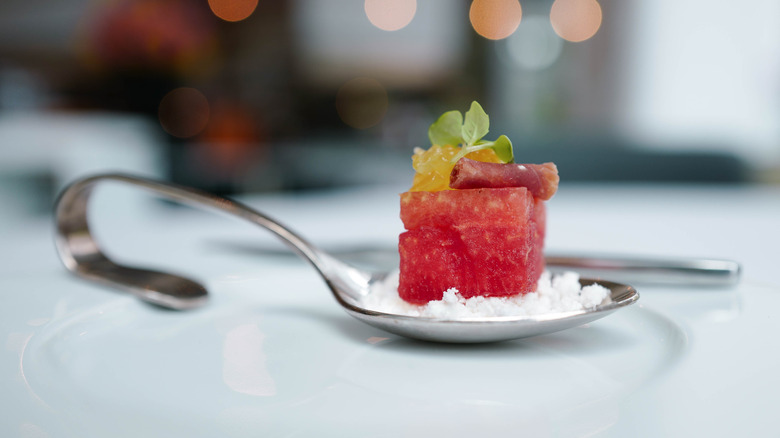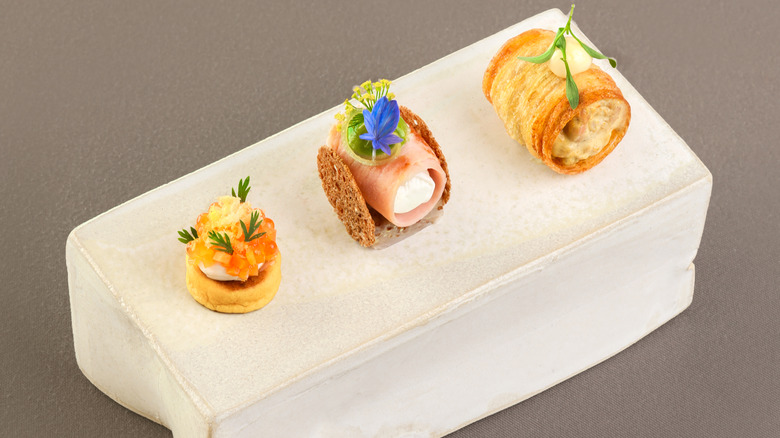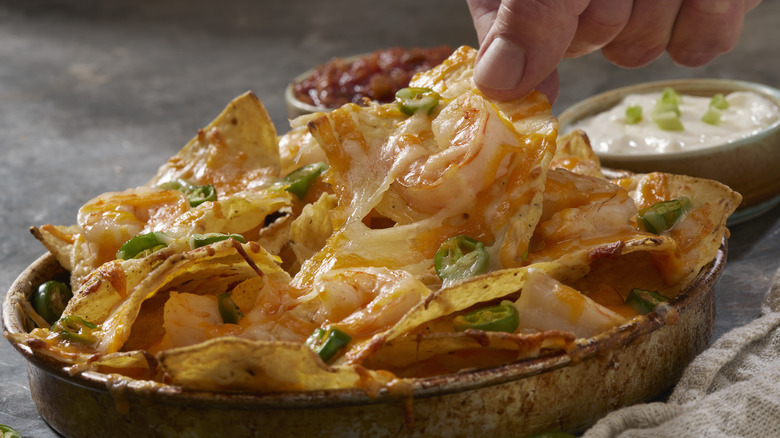What Is An Amuse Bouche And Why Is It Different From An Appetizer?
There are a ton of French words and phrases that have made it into the English vernacular, and a lot of them are food-focused: sauté, fricassée, and crêpe, just to name a few. But the one that might be the most associated with fine-dining is "amuse-bouche" (pronounced "ahmooz-boosh"). It's not only fun to say — it's also fun to eat.
In the world of fine-dining, an amuse-bouche is a complimentary small bite served at the start of a meal, often presented as "a gift from the chef." The word "amuse-bouche" is a portmanteau of two French words: "amuser" (meaning "to amuse") and "bouche" (meaning "mouth"). It's a category whose name literally means "mouth-amuser," or "that which amuses the mouth." What's not to like?
But how is an amuse-bouche different from just a regular ol' appetizer, or that other French word that signifies small bites: hors d'oeuvres? An amuse-bouche is often served at fine-dining restaurants, serves a specific purpose, and functions differently than an appetizer.
Small bite, big flavor
An amuse-bouche is a tiny dish that consists of one or two bites and serves as a chef's first impression to diners. It may be small, but it packs big flavors, meant to awaken the palate in preparation for the meal to come. It piques the diners' appetites and interests, and showcases the culinary skill of the kitchen. Yes, it's fancy, but it's also usually fun and playful. (Like this episode of "Top Chef" Season 20 that asked the contestants to whip up creative amuse-bouche on Ritz crackers.)
These small bites are typically eaten by hand, rather than with a fork, and presented in an aesthetically-pleasing, creative way. Often they're set on a hand-held edible, like a chip or cracker, or served in a compact vessel, like a soup spoon, a toothpick, or even a shot glass. An amuse-bouche sets the tone for the meal, both in flavor and in presentation, and tends to make the diner feel special.
The history of serving amuse-bouche started in France as part of the nouvelle cuisine movement in the 1970s, where the focus shifted away from featuring rich sauces and toward highlighting fresh produce. This was also a time when chefs became more competitive with one another, one-upping each other in creativity and technique. Today, you'll find an amuse-bouche at the start of your meal when dining at many Michelin-starred restaurants.
The difference between an amuse-bouche and an appetizer
Even though Merriam-Webster defines appetizer as "a food or drink that stimulates the appetite and is usually served before a meal," appetizers today often take a different form. These days, many classic American appetizers, like mozzarella sticks and nachos, are often appetite-filling, rather than appetite-stimulating. Other common appetizers, such as steak tartare or Caesar salad, are considered part of the meal and can sometimes be your entire dinner! Different from a modern-day appetizer, which these days tends to satiate hunger (in some capacity at least), an amuse-bouche is designed to stimulate hunger, especially if the bite has plenty of umami.
You also don't get to choose your amuse-bouche like you do with an appetizer. Rather the chef dictates what it is, and usually every restaurant guest is served the same one. While appetizers are listed on a restaurant's menu, amuse-bouches often change regularly, acting as a way for a chef to test out new ideas. And because amuse-bouches are considered "gifts" from the kitchen, they're usually free of charge. (No restaurant is giving out free full-size appetizers to every guest at the start of a meal.)
As for the difference between amuse-bouches and hors d'oeuvres? Hors d'oeuvres (pronounced "or-DERVS") are small bites served to guests separately from the main meal outside a restaurant setting, like at a cocktail party or a wedding. So the next time you're at a fine-dining restaurant, you just might say "bon appétit" to an amuse-bouche.


